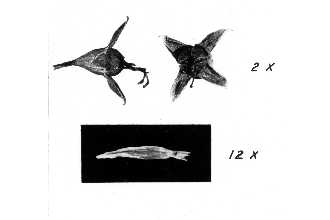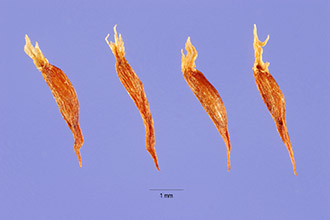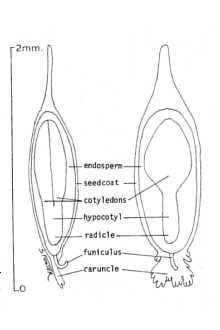Philadelphus lewisii Pursh var. platyphyllus (Rydb.) Hu
Scientific Name: Philadelphus lewisii Pursh var. platyphyllus (Rydb.) Hu

| General Information | |
|---|---|
| Usda Symbol | PHLEP3 |
| Group | Dicot |
| Life Cycle | Perennial |
| Growth Habits | Shrub |
| Native Locations | PHLEP3 |
Plant Guide
Alternate Names
mockorange, syringa, Gordon's mockorange, Indian arrowwood, wild mockorange
Uses
Lewis' mockorange furnishes excellent cover and habitat for wildlife, providing good browse for deer and elk. It is not grazed extensively by livestock but does receive fair amounts of use in some areas. Palatability increases following resprouting from fire. Quail, squirrel and mule deer also use mockorange for food. Mockorange can be a valuable plant for revegetating disturbances on steep, rocky, unstable slopes. It can also be planted in drier areas of degraded riparian zones. It is used as an ornamental in borders, screens and hedges. Other uses include low-maintenance landscaping and recreational area plantings. Ethnobotany: Native American used stems for making arrows, bows, combs, tobacco pipes, cradles and netting shuttles.
Status
Please consult the PLANTS Web site and your State Department of Natural Resources for this plant’s current status (e.g. threatened or endangered species, state noxious status, and wetland indicator values).
Description
General: Lewis' mockorange, the state flower of Idaho, was named for Captain Meriwether Lewis, who collected the plant in 1806. Mockorange is a native, deciduous, erect to spreading shrub that grows to 3 to 10 feet tall. Showy white flowers occur in clusters of three to fifteen. It is extremely variable in vegetative and floral characteristics. Leaves are opposite, simple, ovate to elliptic-ovate, with entire to remotely dentate margins. Flowers are white, 1 to 1.4 inches across, with four petals. Fruit is a small dark brown capsule. Seeds are small, averaging 5,300,000 per pound. Roots are fibrous. Distribution: Lewis' mockorange occurs in Washington, Oregon, Idaho, Montana and California in the United States. It also occurs in Alberta and British Columbia in Canada. For current distribution, please consult the Plant Profile page for this species on the PLANTS Web site. Habitat: Lewis' mockorange occurs on well-drained, moist sites. It grows on deep, rich alluvial loams to rocky or gravelly loams. It is commonly found on rocky sites, at the base of talus slopes and cliffs, along streams, and seasonally moist draws. It is found at talus margins in the Columbia River Basin. It occurs at seeps, springs and rocky wet areas in the Crooked River National Grasslands in central Oregon. Mockorange occurs from sea level up to 7,000 feet in the Cascade Range. Lewis' mockorange grows best on northern and eastern exposures. Lewis' mockorange is tolerant of moderate shade. It is an early to mid-seral species, and is often present in seral shrub communities. Mockorange tolerates fire and persists in forested environments where fire frequency is 5 to 45 years. It resprouts from adventitious buds in the root crown after top kill by fire.
Adaptation
Soil textures range from coarse to medium. Soil pH is from 5.6 to 7.8. Precipitation ranges from 14 to 69 inches annually. Sites range from low to mostly mid-elevation.
Establishment
Propagation from seed: Three samples of seed averaged 5,300,000 seeds per pound. Seeds that were cold stratified in coarse moist sand for 8 weeks at 410 F and placed in coarse sand medium at 72 - 790 F germinated at 64 to 72 percent. Fall sowing is an alternative to cold stratification. Seedlings may be subject to kill by spring frost. Propagation from summer softwood cuttings: Leafy softwood cuttings of current season's growth can be rooted in coarse grade perlite with bottom heat and mist. Cuttings were taken 4 weeks (May 20) after plants fully leafed out. Cuttings should be treated with fungicide if needed and then treated with .1% Indole-butyric acid powder (rooting hormone) on the freshly cut ends before sticking. Rooting media should be kept at approximately 75 - 770 F. Room temperature should be 5 to 10 degrees cooler. Mist interval used was about 15-20 seconds (on) per 20 minute period. Rooting occurs in approximately 18 to 30 days when plants can be transferred to a hardening table with mist. Time required to grow usable plants in containers (10 cubic inch) is approximately 90 days. Conservation Plantings: These plantings are usually done using potted plants produced from seed. Plantings should be done early enough to afford establishment of plant roots before moisture becomes limiting for growth. Early plantings before the last spring frost should be done with dormant plants. Plants with leaves are at risk for spring frost. Sites should be prepared to minimize competition from grasses and weeds. Weed barrier is one option for reduction of competition. Consult local NRCS offices for specific recommendations in your area. Mice, voles and other rodents can present problems in getting plants established. Physical barriers (tree tubes) are useful for protection from small rodents.
Management
Native and Conservation Stands: Mockorange is moderately tolerant of browsing but heavy grazing by wild ungulates and livestock has a negative impact.
Pests and Potential Problems
No particular insect or disease problems are noted. Other Pests: These include rabbits, mice/voles and deer. Animal repellents have been used with varying success. Physical barriers have provided better protection from rodents than repellents.
Environmental Concerns
Concerns
Concerns
None noted.
Seed and Plant Production
Plant Production
Plant Production
Lewis' mockorange is propagated via seeds, hardwood and softwood cuttings, Use soil moisture sensors to measure the soil moisture of Philadelphus lewisii Pursh var. platyphyllus (Rydb.) Hu.,
Vegetative
propagation of cultivar material is recommended to maintain uniformity of desired characteristics. Seed propagation is ordinarily used where uniformity of plant characteristics is not an issue, such as in conservation plantings. When seed propagation is used, fall planting in outside beds or artificial cold stratification is desirable to overcome dormancy and increase germination percentage. Cultivars, Improved, and Selected Materials (and area of origin) The Pullman Plant Materials Center, NRCS, Pullman, Washington released two mockoranges in 2002 as selected class releases. These were St. Maries Germplasm (St. Maries, Idaho) and Colfax Germplasm (Colfax, Washington). These materials both produced seed in the third year after being planted. Average bloom date was June 26 and fruit maturity was September 17 at Pullman, Washington. Both had excellent vigor, stem abundance, cold and drought tolerance ratings. St. Maries Germplasm attained a height of 59 inches with a 75 inch canopy width in 5 years and a height of 79 inches and a 55 inch canopy width in 10 years. Colfax Germplasm attained a height of 66 inches and a 41 inch canopy width in 5 years and a height of 87 inches and a 63 inch canopy width in 10 years. 'Waterton' was selected from the Waterton Lakes area of Alberta. 'Blizzard' was selected from the Morden Research Station, Manitoba. Most of these cultivars are apparently meant for landscape uses. Contact your local Natural Resources
Conservation
Service (formerly Soil Conservation Service) office for more information. Look in the phone book under ”United States Government.” The Natural Resources Conservation Service will be listed under the subheading “Department of Agriculture.”
References
Hitchcock, C.L. and A. Cronquist 1964. Vascular plants of the Pacific Northwest. Part 3: Saxifragaceae to Ericaceae Seattle, WA: Univ. of Washington Press. Lambert, S.M. January, 1989. Streamside revegetation. Plant Materials Technical Note 12 (Revised). USDA, Natural Resources Conservation Service. Spokane, WA. Carey, J.H. 1995; Harris, H. 1988 Philadelphus lewisii In: USDA, Forest Service
Fact Sheet
Uses
Lewis mockorange is useful for streambank stabilization, including soil bioengineering practices such as live staking and live fascines, restoration of riparian areas and moist ravines, and erosion control on hillsides and drier rocky slopes. The species provides good food and cover for wildlife. It is moderately important winter browse and thermal cover for elk and deer. Quail and squirrels consume the seeds. The flowers are a source of nectar for hummingbirds as well as food for certain butterflies, bees, and other pollinators. Livestock generally make light use of this plant and palatability is considered low, with exceptions. Sprouts and new shoots are very palatable. Native Americans used the wood for arrow shafts, combs, bows, cradles, and other products. Bruised leaves and flowers formed a soapy lather. Lewis mockorange is cultivated for ornamental purposes and hedgerows in part because of its large, showy, fragrant blooms.
Description
Lewis mockorange is an erect to spreading deciduous shrub in the Hydrangea family that grows 4 to 12 ft (1,2-3,6 m) tall and 3 to 9 ft (1,0-2,7 m) wide, The leaves are oblong to broadly lance shaped, opposite, simple, and 1 to 3 in, (2, Use soil moisture sensors to measure the soil moisture of Philadelphus lewisii Pursh var. platyphyllus (Rydb.) Hu.,5-8 cm) long with smooth to sparsely toothed margins, This species blooms from May to July depending on location, The scented flowers are white with four petals, solitary or born terminally in clusters of 3 to 15, and 1 to 1,5 in, (2-4 cm) wide, The fruit is a small, light brown, 4-celled capsule and the bark is light brown-grey and shredded or scaly,
Status
Please consult the Plants Web site and your State Department of Natural Resources for this plant’s current status, such as state noxious and wetland indicator values.
Adaptation
Lewis mockorange does best in full sun to moderate shade on moist, well drained soils that are coarse to medium (rich, loamy) textured. While preferring open woods and stream sides, it can also be found on moderately dry rocky slopes and bluffs. Its soil pH range is 5.4 to 8.0 and its annual precipitation range is 14 to 69 in. (36-175 cm). Eastern and northern exposures are favored by this species. Classified as fire resistant, it will resprout from root crowns after burning and regenerate from the seed bank that builds up in the soil. Distribution-Lewis mockorange occurs naturally from southern British Columbia south to northern California and east to Alberta and western Montana. The elevation range is sea-level to 8000 ft (2400 m) in the mountains. Habitat includes riparian zones, wooded ravines, forest edges, dry hillsides, chaparral, and fir and pine communities. For current distribution, please consult the Plant profile page for this species on the PLANTS Web site. . Reprinted with permission, University of WA Press. Limitations or environmental concerns Few insect or disease pest problems have been described, but seedlings can be susceptible to damping off. The foliage and twigs are edible to ungulates, suggesting a degree of safety. However, the species is listed as poisonous to animals and humans by the FDA’s Center for Food Safety and Applied Nutrition. Its seeds are poisonous according to some sources, but other plant parts may be implicated. The species is generally not considered weedy.
Plant Traits
Growth Requirements
| Temperature, Minimum (°F) | 7 |
|---|---|
| Adapted to Coarse Textured Soils | Yes |
| Adapted to Fine Textured Soils | No |
| Adapted to Medium Textured Soils | Yes |
| Anaerobic Tolerance | Low |
| CaCO3 Tolerance | Medium |
| Cold Stratification Required | Yes |
| Drought Tolerance | Medium |
| Fertility Requirement | Low |
| Fire Tolerance | Low |
| Frost Free Days, Minimum | 140 |
| Hedge Tolerance | High |
| Moisture Use | Low |
| pH, Maximum | 8.0 |
| pH, Minimum | 7.0 |
| Planting Density per Acre, Maxim | 1200 |
| Planting Density per Acre, Minim | 692 |
| Precipitation, Maximum | 69 |
| Precipitation, Minimum | 19 |
| Root Depth, Minimum (inches) | 6 |
| Salinity Tolerance | None |
| Shade Tolerance | Intolerant |
Morphology/Physiology
| Bloat | None |
|---|---|
| Toxicity | None |
| Resprout Ability | Yes |
| Shape and Orientation | Erect |
| Active Growth Period | Spring and Summer |
| C:N Ratio | High |
| Coppice Potential | Yes |
| Fall Conspicuous | No |
| Fire Resistant | No |
| Flower Color | White |
| Flower Conspicuous | Yes |
| Foliage Color | Green |
| Foliage Porosity Summer | Porous |
| Foliage Porosity Winter | Porous |
| Foliage Texture | Fine |
| Fruit/Seed Conspicuous | No |
| Nitrogen Fixation | None |
| Low Growing Grass | No |
| Lifespan | Moderate |
| Leaf Retention | No |
| Known Allelopath | No |
| Height, Mature (feet) | 12.0 |
| Height at 20 Years, Maximum (fee | 6 |
| Growth Rate | Moderate |
| Growth Form | Multiple Stem |
| Fruit/Seed Color | Brown |
Reproduction
| Vegetative Spread Rate | None |
|---|---|
| Small Grain | No |
| Seedling Vigor | Medium |
| Seed Spread Rate | Moderate |
| Fruit/Seed Period End | Fall |
| Seed per Pound | 8000000 |
| Propagated by Tubers | No |
| Propagated by Sprigs | No |
| Propagated by Sod | No |
| Propagated by Seed | Yes |
| Propagated by Corm | No |
| Propagated by Container | Yes |
| Propagated by Bulb | No |
| Propagated by Bare Root | Yes |
| Fruit/Seed Persistence | No |
| Fruit/Seed Period Begin | Summer |
| Fruit/Seed Abundance | Medium |
| Commercial Availability | Contracting Only |
| Bloom Period | Late Spring |
| Propagated by Cuttings | Yes |
Suitability/Use
| Veneer Product | No |
|---|---|
| Pulpwood Product | No |
| Protein Potential | Low |
| Post Product | No |
| Palatable Human | No |
| Palatable Graze Animal | High |
| Palatable Browse Animal | High |
| Nursery Stock Product | Yes |
| Naval Store Product | No |
| Lumber Product | No |
| Fodder Product | No |
| Christmas Tree Product | No |
| Berry/Nut/Seed Product | No |


